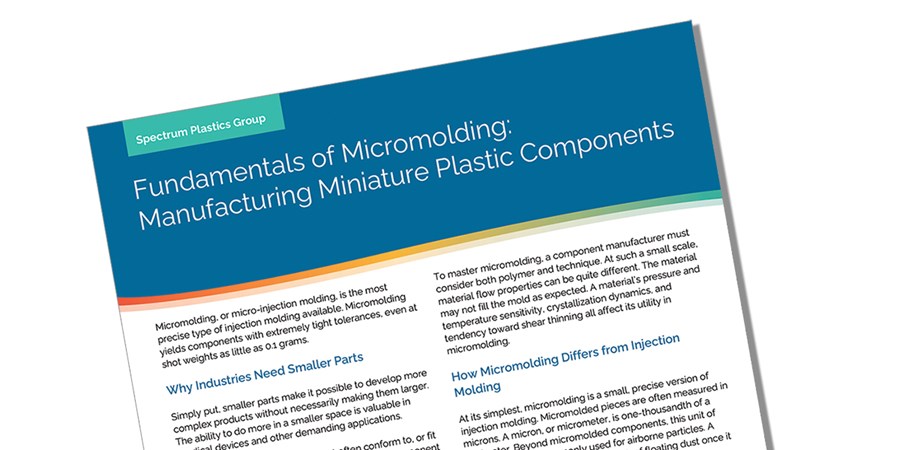Click here to download.
Why Industries Need Smaller Parts
Simply put, smaller parts make it possible to develop more complex products without necessarily making them larger. The ability to do more in a smaller space is valuable in medical devices and other demanding applications.
Medical devices, for example, must often conform to, or fit within, a small space in the human body. Every component must be appropriately sized for the relevant part of the body. For example, neurovascular devices must fit within blood vessels. Ophthalmology and orthopedic devices similarly must work in confined spaces. Surgical deployment devices and instruments require small fixation anchors and screws, especially for surgeries on precise extremities like hands and feet.
Given the minuscule tolerances when it comes to things like minimally invasive surgery, simply being tiny is not enough to make micromolded parts useful. They also have to be extremely reliable, lightweight, and effective. For these applications, micromolding offers the best combination of cost, size, precision, and dependability.
Material Behavior During Micromolding
Micromolding is not without its technical challenges. Because the parts are so small, the tolerances are absolutely minimal. Micromolded parts must be completely precise, even as they form a complex design in a minuscule space. This difficulty is exacerbated by the fact that polymers do not behave as predictably during micromolding as they do in larger injection molds.
To master micromolding, a component manufacturer must consider both polymer and technique. At such a small scale, material flow properties can be quite different. The material may not fill the mold as expected. A material’s pressure and temperature sensitivity, crystallization dynamics, and tendency toward shear thinning all affect its utility in micromolding.
How Micromolding Differs from Injection Molding
At its simplest, micromolding is a small, precise version of injection molding. Micromolded pieces are often measured in microns. A micron, or micrometer, is one-thousandth of a millimeter. Beyond micromolded components, this unit of measurement is commonly used for airborne particles. A human eye can normally see a speck of floating dust once it reaches a size of 25 microns.
Because of the small size of micromolded pieces and the behavior of materials during micromolding, the process requires highly specialized injection units. Other than that, the micromolding process looks extremely similar to typical injection molding. That is, thermoplastic polymers are melted, pressurized, and injected into double-sided molds.
Measuring Small Parts
To accurately assess tiny parts, one must be able to see fine detail. Micromolded parts are measured in microns to keep tolerances to the absolute minimum. This level of precision in measuring and quality control requires specialized inspection equipment.
Inspectors can use equipment with laser, vision, and touch-trigger capabilities to confirm the dimensions of micromolded parts. For example, a computed tomography (CT) system generates a very high precision 3D point cloud of a part through the process of CT scanning. The digitized 3D point cloud is much easier to inspect than the original physical component measured. By measuring the point cloud, inspectors get an accurate measurement of the part itself.
CT systems can yield accurate measurements to the micrometer, and even to the nanometer. Measuring in units 1,000 times smaller than even a micrometer helps inspectors observe every detail of a micromolded part. The challenge lies in creating parts to stand up to such thorough inspection.
The Challenges of Micromolding
Material behavior during micromolding isn’t the only challenge. Once the scale gets small enough that even polymer behavior starts changing, several other technical requirements get harder to meet. Because the produced components are small, the molds must be small as well.
The molds also have to be able to form components with complex shapes, even at this small size. On top of small size and immaculate precision, molds for micromolding have to be extremely durable. They can’t deflect when polymers are injected at high pressure.
Injection molding often leaves components with small imperfections, like gate vestiges where material enters the molding cavity. Gate vestiges are much more impactful on micromolded parts than they are on larger parts. When they occur, they must be trimmed or recessed into the part to ensure proper function and a proper fit. A vestige must be removed in such a way that it preserves the integrity of the part.
Contact a Micromolding Specialist
Spectrum Plastics Group approaches micromolding with the skills and expertise necessary to ensure precise quality. The team possesses decades of experience, and our knowledgeable engineers are backed by industry leading quality control systems. Our team brings a deep understanding of design, materials, and micromolding processes to our partnerships.
Our micromolded components are vital to medical devices, as well as to products in the robotics, pharmaceutical, industrial, defense, and food and beverage industries. The experienced engineers at Spectrum Plastics Group are happy to help with your project however we can. Contact us today to learn more about micromolding and discuss micromolded components.

